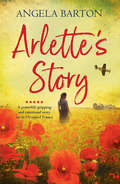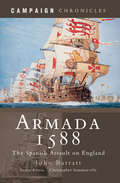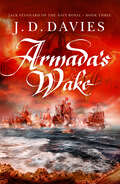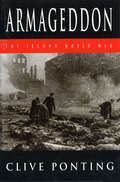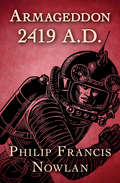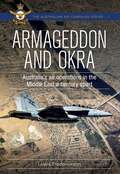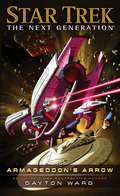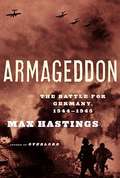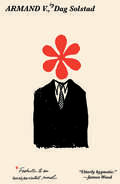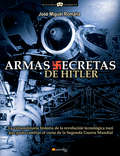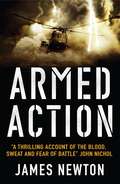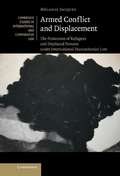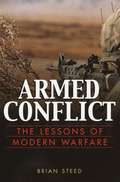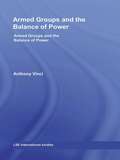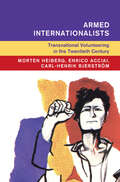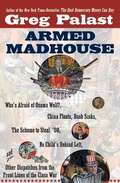- Table View
- List View
Arlette's Story
by Angela Barton&“A beautifully written novel . . . which captures life in occupied France during the Second World War&” from the author of Magnolia House (That Thing She Reads). One woman&’s struggle to protect the ones she loves . . . When Arlette Blaise sees a German plane fly over the family farm in 1940, she&’s comforted by the fact that the occupying forces are far away in the north of the country. Surely the war will not reach her family in the idyllic French countryside near the small town of Oradour-sur-Glane? But then Saul Epstein, a young Jewish man driven from his home by the Nazis, arrives at the farm and Arlette begins to realize that her peaceful existence might be gone for good . . . &“Absolutely gorgeous . . . an excellent book that really brings home just how horrific [WWII] must have been.&”—Donna&’s Book Blog
Armada 1588: The Spanish Assault on England (Campaign Chronicles Ser.)
by John BarrattThe political machinations, the strategies, and the hour-by-hour accounts of the war that locked Elizabeth I and Philip II in a battle for naval supremacy. The defeat of the Spanish Armada is one of the turning points in English history, and it was perhaps the defining episode in the long reigns of Elizabeth I of England and Philip II of Spain. The running battle along the Channel between the nimble English ships and the lumbering Spanish galleons has achieved almost legendary status. In this compelling new account John Barratt reconstructs the battle against the Armada in the concise, clear Campaign Chronicles format, which records the action in vivid detail, day by day, hour by hour. He questions common assumptions about the battle and looks again at aspects of the action that have been debated or misunderstood. Included are full orders of battle showing the chains of command and the effective strengths and fighting capabilities of the opposing fleets.There is also an in-depth analysis of the far-reaching consequences of the wreck of Philip II&’s great enterprise.
Armada's Wake (Jack Stannard of the Navy Royal)
by J. D. DaviesThe beacons are lit – the Armada is sighted off the English coast. The thrilling final instalment of the Navy Royal trilogy.1588: The greatest naval force of its age bears down upon England. As a devastating battle looms, a nation holds its breath.Jack Stannard, grandson of the original Jack, is stationed on Drake’s warship Revenge. His father, Tom, commands his own vessel and even his grandfather is close by. Each must be ready for the greatest battle of their lives.Everything is at stake: the fleet, the Queen, England and behind it all something even more binding. Family. On every front they must triumph...A brilliant and intricate portrait of one of the world's most important sea battles and its aftermath, Armada's Wake is a masterpiece of historical adventure, perfect for fans of Patrick O’Brian, C. S. Forester and Bernard Cornwell.
Armada: The Spanish Enterprise and England's Deliverance in 1588
by Geoffrey Parker Colin MartinThe definitive history of the Spanish Armada, lavishly illustrated and fully revised“Will surely become the definitive account.”—Stephen Brumwell, Wall Street Journal In July 1588 the Spanish Armada sailed from Corunna to conquer England. Three weeks later an English fireship attack in the Channel—and then a fierce naval battle—foiled the planned invasion. Many myths still surround these events. The genius of Sir Francis Drake is exalted, while Spain’s efforts are belittled. But what really happened during that fateful encounter? Drawing on archives from around the world, Colin Martin and Geoffrey Parker also deploy vital new evidence from Armada shipwrecks off the coasts of Ireland and Scotland. Their gripping, beautifully illustrated account provides a fresh understanding of how the rival fleets came into being; how they looked, sounded, and smelled; and what happened when they finally clashed. Looking beyond the events of 1588 to the complex politics which made war between England and Spain inevitable, and at the political and dynastic aftermath, Armada deconstructs the many legends to reveal why, ultimately, the bold Spanish mission failed.
Armageddon
by Clive PontingFifty years after the end of World War II Clive Ponting provides a major reassessment of the most destructive conflict in human history - one in which 85 million people died.Armageddon avoids conventional chronological accounts in order to concentrate on the deeper forces shaping the origins, course and outcome of the war across the globe. It analyses how and why the war spread from being a limited European conflict to the only global war, why countries were dragged into the fighting and how only a small number of neutral states escaped. It compares the two alliances, how they mobilized their resources and their strategies for victory. It avoids a detailed description of how commanders maneuvered on the battlefield and concentrates instead on the impact the war had on individual soldiers, sailors and airmen. Equally important is the fate of hundreds of millions of civilians. How did they survive occupation and what did resistance, collaboration and liberation really involve, and what happened at the end of the war?Armageddon has a truly global sweep, combined with an eye for detail, and provides fascinating comparisons from a multi-faceted war. It contains new facts, asks provocative questions and challenges many of the common assumptions about the war. It is a compelling new inquiry.
Armageddon
by Leon UrisIn Berlin at the end of World War II, an American Army officer bears witness to the aftermath of one historic tragedy and the rise of another Captain Sean O'Sullivan distinguishes himself as a courageous soldier in the closing days of World War II, but what comes next tests his deepest reserves of strength and conviction. Sent to oversee the rebuilding of Berlin, O'Sullivan is exposed to the horrific truths of the Holocaust, a shattered and defeated society, and the new threat of Soviet power as the Iron Curtain begins to shadow the city. When Soviet forces blockade Berlin and the airlift begins, O'Sullivan is faced with profound moral dilemmas in an increasingly complicated world. Armageddon is one of the great fictional portrayals of Europe in the earliest days of the Cold War. This ebook features an illustrated biography of Leon Uris including rare photos from the author's estate.
Armageddon 2419 A.D. (The Buck Rogers Adventures)
by Philip Francis NowlanThe groundbreaking novella that gave rise to science fiction&’s original space hero, Buck Rogers. In 1927, World War I veteran Anthony Rogers is working for the American Radioactive Gas Corporation investigating strange phenomena in an abandoned coal mine when suddenly there&’s a cave-in. Trapped in the mine and surrounded by radioactive gas, Rogers falls into a state of suspended animation . . . for nearly five hundred years. Waking in the year 2419, he first saves the beautiful Wilma Deering from attack and then discovers what has befallen his country: The United States has descended into chaos after Asian powers conquered the world with advanced weaponry centuries before. All that&’s left are ragtag gangs battling for survival against their brutal overlords. But when Rogers shows them how to band together and fight for more than mere survival, he sparks a revolution that will decide the fate of the future world. This ebook has been professionally proofread to ensure accuracy and readability on all devices.
Armageddon Road: A VC's Diary, 1914–1916
by Billy CongreveBilly Congreve was an exceptional soldier and an exceptional man. By the time he was killed on the Somme in July 1916 at the age of twenty-five he had been awarded the DSO, MC, and the Lgion d'Honneur, and for his many deeds of gallantry on the Somme, a posthumous VC.Born into a military family (his father General Congreve had also won the VC) he became a regular soldier in the Rifle Brigade before the war, and in France became a staff officer, but one who chose to be in the front line as often as he could. This makes his remarkable diaries all the more valuable since he writes from the thick of the fighting and yet retains an objectivity that enables him to observe all that is going on around him both in the trenches and at headquarters.Terry Norman carefully edited the diary to set his story in the context of the war, and thus provide an exceptional picture of what an officer thought of the conduct of the war side by side with his personal grief at the loss of his friends and the wastage of human life.Out of print for over 30 years, this special centenary edition of this classic work includes a new foreword from esteemed military author Nigel Cave, as well as an expanded introduction from Terry's widow, Joan and a newly designed plate section. Detailing the extraordinary exploits of a truly remarkable man during the first two years of the war, this book is a compulsive purchase for all fans of the period.
Armageddon and OKRA: Australia's air operations in the Middle East a century apart (Australian Air Campaign Series #1)
by Lewis FredericksonThe dispatch of an Ottoman Army by Australian-led Imperial air power in the Wadi Fara on 21 September 1918 occurred just five years after the advent of military aviation in Australia. In 1914, the fledgling Australian air service operated the flimsy Bristol Boxkite; four years later it was flying the far more advanced Bristol F2B Fighter. This leap forward represented a profound progress in technology that has typified the technical development of aviation, particularly in Australia ever since. Ironically, on 21 September 2014, 96 years after the events of the Wadi Fara, Australian squadrons were again deployed to the same part of the world where they would remain for more than three years on operations against extremist terrorism. Armageddon and OKRA contrasts these events, a century apart, in the context of the development of Australian air power. The book tracks the history where Australia has maintained a balanced air service compelling high technical, logistics and engineering standards, and effective training and command and control systems, for more than 100 years. These processes were as applicable a century ago as they are today. By examining these operational events, the author establishes the connection that access to the technology associated with air power is intrinsically linked to Australia&’s enduring foreign and defence policy – more so, that military power is a means to an end, and never an end unto itself.
Armageddon's Arrow: Armageddon's Arrow (Star Trek: The Next Generation)
by Dayton WardAn all-new novel of The Next Generation expanded universe from the New York Times bestselling author!It is a new age of exploration, and the USS Enterprise is dispatched to &“the Odyssean Pass,&” a region charted only by unmanned probes and believed to contain numerous inhabited worlds. Approaching a star system with two such planets, Captain Jean-Luc Picard and his crew find a massive alien vessel, drifting in interstellar space for decades. Sensors detect life aboard the derelict—aliens held in suspended animation. Thought to be an immense sleeper ship, the vessel actually is a weapon capable of destroying entire worlds...the final gambit in a war that has raged for generations across the nearby system. Captain Picard is now caught in the middle of this conflict and attempts to mediate, as both sides want this doomsday weapon…which was sent from the future with the sole purpose of ending the interplanetary war before it even began!
Armageddon's Walls: British Pill Boxes, 1914–1918
by Peter OldhamThe British Army and her commonwealth Allies went to war in 1914 with little knowledge and experience of constructing permanent, shell proof protective structures. Some masonry fortifications, such as defensive blockhouses in South Africa, had been built but the Royal Engineers of the Army were more versed in simple temporary defences suitable for mobile warfare. Home defences were a limited number of forts around naval ports, and Martello Towers on the east coast. It was considered that the Navy was quite able to defend Britain's coasts.The Germans, on the other hand, as with the other continental countries such as France, Belgium, Italy, Holland, Poland, Austria, etc. had been constantly renewing and updating border forts for several centuries. They had also maintained fortification and siege elements of their armies, who were experienced in designing and constructing strong shelters. Both German and French armies began the war with a degree of expertise in what was to become a static war with little movement. However, by 1918 the British were to surpass both enemy and her allies in the design and construction, with supply and logistics, of such shell proof cover for troops and defensive positions.This book gives the history of development and innovation of concrete bunkers, pill boxes, blockhouses and general concrete constructions during the First World War. Many of these structures some showing obvious signs of war damage - still exist in France and Belgium today.All the existing structures, with photograph (except for some which are impractical, because of dense vegetation,) are shown within. Many entries have contemporary maps showing how they fitted into a defensive system, whilst for others the location can be identified from the text. GPS coordinates are given for each entry, except for a few which are on private land and where privacy has been requested.
Armageddon: A Novel Of Berlin
by Leon UrisIn Berlin at the end of World War II, an American Army officer bears witness to the aftermath of one historic tragedy and the rise of another. Captain Sean O'Sullivan distinguishes himself as a courageous soldier in the closing days of World War II, but what comes next tests his deepest reserves of strength and conviction. Sent to oversee the rebuilding of Berlin, O'Sullivan is exposed to the horrific truths of the Holocaust, a shattered and defeated society, and the new threat of Soviet power as the Iron Curtain begins to shadow the city. When Soviet forces blockade Berlin and the airlift begins, O'Sullivan is faced with profound moral dilemmas in an increasingly complicated world. Armageddon is one of the great fictional portrayals of Europe in the earliest days of the Cold War.
Armageddon: The Battle for Germany, 1944-45
by Max HastingsIn September 1944, the Allies believed that Hitler's army was beaten and expected the bloodshed to end by Christmas. Yet a series of mistakes and setbacks, including the Battle of the Bulge, drastically altered this timetable and led to eight more months of brutal fighting. With Armageddon, the eminent military historian Max Hastings gives us memorable accounts of the great battles and captures their human impact on soldiers and civilians. He tells the story of both the Eastern and Western Fronts, raising provocative questions and offering vivid portraits of the great leaders. This rousing and revelatory chronicle brings to life the crucial final months of the twentieth century's greatest global conflict.From the Trade Paperback edition.
Armand V
by Steven T. Murray Dag SolstadNew Directions proudly introduces two novels in English by the Norwegian master, who is “without question, Norway’s bravest, most intelligent novelist” (Per Petterson) Armand is a diplomat rising through the ranks of the Norwegian foreign office, but he’s caught between his public duty to support foreign wars in the Middle East and his private disdain for Western intervention. He hides behind knowing, ironic statements, which no one grasps and which change nothing. Armand’s son joins the Norwegian SAS to fight in the Middle East, despite being specifically warned against such a move by his father, and this leads to catastrophic, heartbreaking consequences. Told exclusively in footnotes to an unwritten book, this is Solstad’s radically unconventional novel about how we experience the passing of time: how it fragments, drifts, quickens, and how single moments can define a life.
Armas secretas de Hitler (Historia Incógnita)
by Miguel José RomañaDurante los dos últimos años de la Segunda Guerra Mundial, los avances tecnológicos logrados por Alemania fueron sorprendentes. Junto a aviones a reacción de los más variados y vanguardistas diseños, llegaron las aeronaves discoidales de prestaciones nunca imaginadas. A ello se unieron “armas maravillosas” como misiles para cualquier acción bélica, increíbles “bolas de fuego”, submarinos indetectables, cañones sónicos y eléctricos, la bomba endotérmica, y un largo etcétera de armamento prodigioso.
Armed Action
by James Newton, Dfc'I couldn't see the tank. I couldn't see it... Someone was screaming over the radio. "Scream all you want, I still can't see it," I said to my pilot. The next explosion was so close it lifted my chest armour off my body in the shock wave. The noise brought me back to my awful reality. I looked out of the sight to see the shattered cockpit glass. The next one would be it and we knew it.' Lieutenant Commander James Newton survived and was awarded the Distinguished Flying Cross for his bravery. In a career that has seen him on operations over Bosnia, Sierra Leone, Northern Ireland and most recently Iraq, Newton is no stranger to being shot at. He has flown all the aircraft the Navy has and even ones it doesn't. Thrilling, fast-paced and an adrenaline-fuelled adventure, Armed Action is a fascinating insight into life in the air.
Armed Batavians: Use and Significance of Weaponry and Horse Gear from Non-military Contexts in the Rhine Delta (50 BC to AD 450) (Amsterdam Archaeological Studies)
by Johan NicolayThis study explores the use and significance of Roman weaponry and horse gear from non-military contexts in the eastern Rhine delta – the territory of the Batavians. Using a life-cycle model for Roman soldiers, the author interprets the large quantity of 1st-century finds as personal memorabilia brought home by ex-soldiers as a reminder of their 25 years of service, symbolising their newly-acquired veteran status. Underpinning the research is an extensive inventory of militaria from urban centres, rural settlements, cult places, rivers and graves, presented in 96 plates. The study not only presents a considerable body of unpublished data, but also offers an intriguing perspective on daily life in the northern frontier of the Roman Empire, with its closely interwoven military and civilian values.Amsterdam Archaeological Studies is a series devoted to the study of past human societies from the prehistory up into modern times, primarily based on the study of archaeological remains. The series will include excavation reports of modern fieldwork; studies of categories of material culture; and synthesising studies with broader images of past societies, thereby contributing to the theoretical and methodological debates in archaeology.
Armed Conflict and Displacement
by Mélanie JacquesWith 'displacement' as the guiding thread, the purpose of this study is twofold. Firstly, it derives from the relevant provisions of international humanitarian law a legal framework for the protection of displaced persons in armed conflict, both from and during displacement. It contains a case study on Israeli settlements in the Occupied Palestinian Territory and the recent Advisory Opinion on the Separation Wall, and addresses such issues as humanitarian assistance for displaced persons, the treatment of refugees in the hands of a party to a conflict and the militarisation of refugee camps. Secondly, it examines the issue of displacement within the broader context of civilian war victims and identifies and addresses the normative gaps of international humanitarian law, including the inadequacy of concepts such as 'protected persons' and the persistence of the dichotomy between international and non-international armed conflicts, which is at odds with the realities of contemporary armed conflicts.
Armed Conflict and Human Rights Law: Protecting Civilians and International Humanitarian Law (Globalization: Law and Policy)
by Daniel Ivo OdonThis book explores developments in international law regarding the relationship between human rights law and international humanitarian law and their coapplicability in armed conflict situations. The work examines the jurisprudence of the international human rights courts and looks at the Inter-American and European Courts of Human Rights case law in dealing with new emergencies in armed conflicts. It argues that a new interpretation and application of the law is required to deal with current needs while remaining faithful to moral commitments made in the international arena. In this way, the book deals with recent cases and their rationale to build a new understanding of law and international policy that complies with the globalization process and progress towards an enhancement of the international community’s legal framework. Combining the emergencies in armed conflicts with the mutual enforcement of human rights law and humanitarian law, this book holistically develops concepts and theories to present a pragmatic solution to moral quandaries over the targeting of civilians during armed conflict situations. The book will be a valuable resource for academics, researchers and policy-makers in the areas of international human rights and international humanitarian law.
Armed Conflict: The Lessons of Modern Warfare
by Brian SteedWhat challenges will America face in armed conflicts of the future and how will we prepare for them? National security depends upon the ability of the military to predicto the future nature of war. Despite the difficulty in making such predictions, one must remember: nation states and other countries will continue to use armed conflict as a means to further their aims, and these aims will, at times, run contrary to American interests. As a result, the United States will continue to be confronted with armed conflict in the days and years ahead. A military theorist and experienced armor officer, Brian Steed provides insights into the future of armed conflict by focusing on what has occurred in the pastunot because the past repeats itself, but because it reveals timeless principles of warfare. Five battles, one each in Korea, Vietnam, the Falklands, the Persian Gulf, and Somalia are analyzed historically, geographically, and strategically. Steed's analysis of these engagements clearly demonstrates that the key to victory on the battlefields of the future is the small unit. In refreshing layman's prose, the author focuses on why the events occurred as they did, and explores the significance of each battle in terms of its political and military ramifications. He concludes with lessons learned that will greatly benefit future American ground combat commanders. Armed Conflict informs the reader about the historical trends of combat operations and the realities of warutoday and into the future. It will also serve to guide a new generation of military and civilian leaders as they prepare to face the inevitable conflicts in the new century.
Armed Forces in the Middle East: Politics and Strategy (Besa Studies In International Security)
by Barry Rubin Thomas A. KeaneyAn examination of the Middle East's leading armed forces and their role in both military and political affairs. The book considers their missions, doctrine, training, equipment and effectiveness as fighting forces.
Armed Groups and the Balance of Power: The International Relations of Terrorists, Warlords and Insurgents (LSE International Studies Series)
by Anthony VinciThis new book provides a framework for understanding the international relations of armed groups, including terrorist organizations, insurgencies and warlords, which play an increasingly important role in the international system. Specifically, the book argues that such groups can be understood as taking part in the balance of power with states and other armed groups, as they are empirically sovereign non-state actors that are motivated by the pursuit of power and exist as part of an anarchic, self-help system. This radically new approach offers a renewed conceptualization of Neorealism, and provides new insights into debates about sovereignty, non-state actors, new wars, counterterrorism, and counterinsurgency. The approach is illustrated through case studies on Somali warlords, the security complex between the Lord’s Resistance Army (LRA), Sudanese People’s Liberation Army (SPLA), Sudan and Uganda, as well as Al Qaeda. The book provides insights into such issues as how non-state actors can be integrated into structural theories of international relations, and also offers pragmatic methodologies for the foreign policy or military practitioner, such as how to best deter terrorists.
Armed Internationalists: Transnational Volunteering in the Twentieth Century (Global and International History)
by Morten Heiberg Enrico Acciai Carl-Henrik BjerströmThis unique transnational history explores the extraordinary lives of left-wing volunteers who fought in not just one, but multiple conflicts across the globe during the mid-twentieth century. Utilising previously unpublished archival material, Heiberg, Acciai and Bjerström follow these individual soldiers through military conflicts that were, in most cases, geographically centred on individual countries but nonetheless evinced a crucial transnational dimension. From the Spanish Civil war of 1936 to the Nicaraguan Revolution of 1979, the authors marshall these diverse case studies to create a conceptual framework through which to better understand the networks and recruitment patterns of transnational volunteering. They argue that the Spanish Civil War created a model for this transnational left-wing military volunteering and that this experience shaped the global left responses to a range of conflicts throughout the twentieth century.
Armed Madhouse
by Greg Palast(From the book jacket) Greg's most provocative and caustically funny book yet, Armed Madhouse brings you the stories not allowed in The New York Times. Armed with more than fifty classified documents, confidential memos, and secret plans liberated from the Pentagon, FBI, World Bank, and ExxonMobil, Palast cuts through the TV news babytalk: Before invading, George Bush didn't have a secret plan to seize Iraq's oil-he had two. Palast shows you both. In "Who's Afraid of Osama Wolf?," Palast reveals the horror and humor of the War on Terror. In "The Network," Palast gives you the skinny on the new global order-and pushes Thomas Friedman over the edge of his Flat World. It was Palast, for BBC TV, who first uncovered how Jeb Bush and Katherine Harris stole Election 2000. Here he's got a new twist: Palast tells you that Kerry won in 2004-and that 2008 is already fixed.
Armed Organizations and Political Elites in Civil Wars: Pathways to Power in Syria and Iraq (Routledge Studies in Civil Wars and Intra-State Conflict)
by Erwin van VeenThis book analyses under what conditions, and with what developmental effects, armed organizations shift their ‘coercive profile’ during civil wars, with a focus on the recent conflicts in Syria and Iraq.The work begins with an operationalisation of the term ‘political settlement’, focusing on how power is organized in fragile and conflict-affected countries, and then uses this operationalization to analyse the political settlements of contemporary Syria and Iraq, including their breakdown and transformation during recent civil wars (of 2011-today in Syria and 2014-17 in Iraq). It subsequently examines why and how elite factions have used armed organizations in times of conflict. This approach links an understanding of the broad evolution of power relations at the national level with the specific effects of the use of armed organizations on such relations. It argues for a shift from assigning fixed labels to armed organizations during civil wars to studying their coercive profile in a dynamic fashion, i.e. how armed organizations behave in terms of their use of threats and coercive force. The book introduces five profiles of coercive behaviour that demonstrate how the same organization can behave very differently at various points in time. One of these, the ‘hybrid coercive profile’, fills a gap in the existing civil war typology of organized armed violence by opening up the possibility of elite factions deliberately combining collaborative and competitive modes of behaviour. As an evidence base, the book provides in-depth analysis of the origins, evolution and operations of four armed organizations that have acted under a hybrid coercive profile during the Syrian and Iraqi civil wars: the Syrian Kurdish People’s Defence Forces, the Eagles of the Whirlwind of the Syrian Social Nationalist Party, the Iraqi Kurdish Peshmerga and the Badr Organization. By connecting the concepts of political settlement and civil war, and applying them to specific armed organizations operating in Syria and Iraq, the book offers new insights into this nexus.This book will be of much interest to students of civil wars, conflict studies, Middle Eastern Studies and International Relations.
